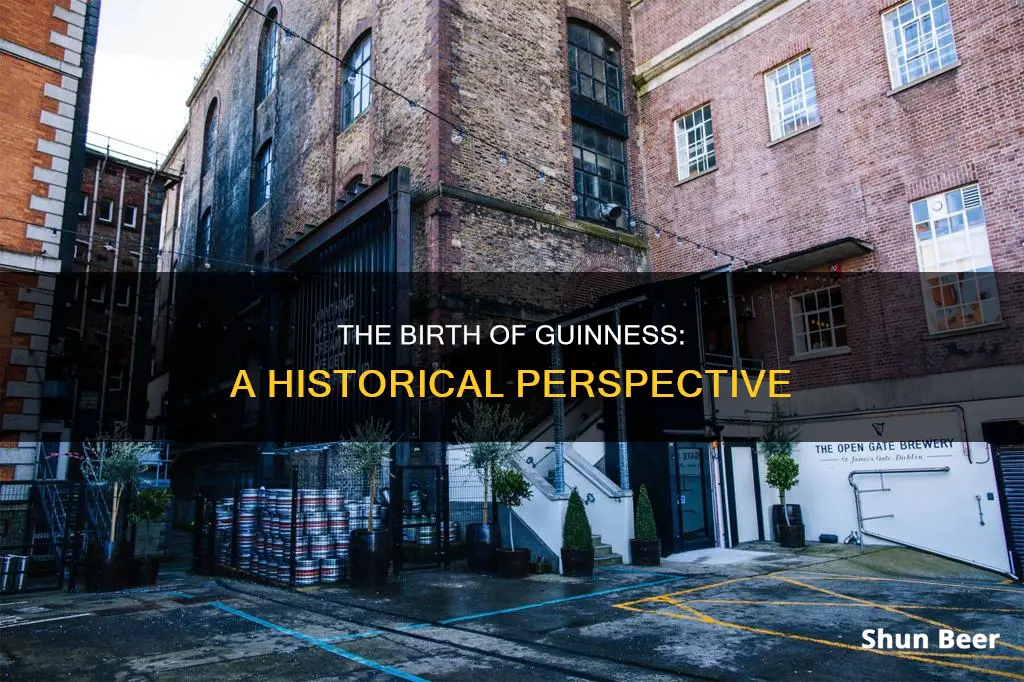
The story of Guinness beer begins in 1759 when Arthur Guinness signed a 9,000-year lease on the St. James's Gate Brewery in Dublin, Ireland. At the time, the brewery was dilapidated, but Guinness turned it into a thriving business, and by 1769 he began exporting his ale to England. Over the years, Guinness beer has become one of the most recognisable brands in the world, with a distinctive flavour and colour that has been maintained for over 250 years.
| Characteristics | Values |
|---|---|
| Year founded | 1759 |
| Founder | Arthur Guinness |
| Brewery location | St. James's Gate Brewery, Dublin, Ireland |
| Type of beer | Stout |
| Main ingredients | Water, barley, roast malt extract, hops, brewer's yeast |
| Colour | Dark ruby red |
| Flavour | Burnt |
| Merger | Grand Metropolitan |
| New company name | Diageo |
What You'll Learn

Arthur Guinness signs a 9,000-year lease on St. James's Gate Brewery in 1759
On 31 December 1759, Arthur Guinness signed a 9,000-year lease on St. James's Gate Brewery in Dublin, Ireland. The lease was for a small, unused, and dilapidated brewery on a four-acre property, which Guinness rented for £45 per year. The lease also granted him the use of a limited supply of water.
The St. James's Gate Brewery was a huge success, and within ten years, Guinness began exporting his ale to England. In the 1770s, he started brewing porter, which became so popular that, in 1799, he decided to stop brewing ale altogether and focus exclusively on the creamy stout.
The brewery was passed on to Guinness's son, Arthur Guinness II, who maintained and grew the business, making St. James's Gate Brewery the largest brewery in Ireland. Arthur Guinness II also expanded exports to markets beyond England, including Lisbon, South Carolina, New York, Barbados, and Sierra Leone.
The lease signed by Arthur Guinness in 1759 played a pivotal role in the history of Guinness beer, allowing the company to establish itself and grow into the successful brand it is today.
Guinness Beer: Pressurizing the Magic Balls
You may want to see also

Guinness Extra Stout is based on an 1821 recipe
The story of Guinness began in 1759 when Arthur Guinness signed a 9,000-year lease on St. James's Gate Brewery in Dublin, Ireland. In 1769, he exported his ale to Great Britain, and in 1778, he started selling dark beer porter. However, it was in 1821 that Arthur Guinness II, the first in a long line of Guinness Master Brewers, set down precise instructions for brewing his Superior Porter, a beer that would become the precursor to every Guinness innovation to follow. This beer, first brewed over 200 years ago, is the basis of Guinness Extra Stout, which is still crafted from the finest quality malt, hops, and Irish barley at the same St. James's Gate brewery today.
Guinness Extra Stout is an iconic stout with sharp, crisp, and trademark Guinness flavours. It has a dark ruby red colour and a frothy head. The taste is a well-rounded balance of bitter and sweet, with warming, roasted notes of coffee and dark chocolate. It is subtly fruity, with a dry finish.
The first beer pairing noted in history involving Guinness Extra Stout was in 1837, when it was enjoyed with oysters by Sir Benjamim Disraeli, the future British Prime Minister. Over the years, Guinness Extra Stout has become a beloved icon around the world, especially in West Indian, West African, and Caribbean communities. It has a rich history and robust flavours that elevate celebrations, whether enjoyed ice-cold or used as a secret ingredient in cooking.
Guinness, as a brand, has a long history of innovation and marketing campaigns. They have pioneered quality control efforts and employee welfare schemes, reflecting Arthur Guinness's legacy of philanthropy. The company has faced challenges, such as declining sales in the 1970s, but has adapted and expanded its product line to cater to diverse tastes and markets. Today, Guinness is one of the most successful alcohol brands worldwide, brewed in almost 50 countries and available in over 120.
The Origins of Guinness Beer: A Historical Overview
You may want to see also

Guinness is made from roasted malted barley
The story of Guinness began in 1759 when Arthur Guinness signed a 9,000-year lease on a small brewery in Dublin, now known as St. James's Gate Brewery. At first, the brewery produced a variety of ales and beers, but over time Guinness began to focus on a dark beer with a rich head, known as porter or stout.
Arthur Guinness was a philanthropist, a pragmatist, an innovator, a family man, and a fighter. He was passionate about brewing and passed on his knowledge to future generations of Guinness master brewers.
Today, Guinness is one of the most recognisable beer brands in the world and is brewed in nearly 50 countries. The brewing process has evolved over the years, with new ingredients and techniques being introduced to improve the flavour and consistency of the beer.
Guinness has a strong following in countries like Nigeria, where there are more Guinness drinkers than in all of Ireland. The beer has become an iconic part of Irish culture and is enjoyed by people of all ages around the world.
Guinness Beer: Decoding Production Dates for Connoisseurs
You may want to see also

The company was incorporated in 1886
In 1886, Edward Cecil Guinness, son of Benjamin Lee Guinness, incorporated the company after his father's death. The Guinness brewery had already become an international brand and the largest in the world. Edward continued his father's legacy of enhancing the welfare of the brewery's workforce. For instance, by 1900, the brewery was operating unparalleled welfare schemes for its 5,000 employees, costing the company £40,000 a year, which was one-fifth of the total wages bill.
In 1886, the St. James's Gate Brewery was the largest in the world. The brewery had been passed down from Arthur Guinness to his son, Arthur Guinness II, who maintained and developed the business. Arthur Guinness II exported his beer worldwide, including to the UK, Lisbon, South Carolina, New York, Barbados, and Sierra Leone.
In October 1886, Guinness became a public company, averaging sales of 1.138 million barrels a year. Despite the brewery's refusal to advertise or offer discounts, the company was valued at £6 million, and shares were 20 times oversubscribed.
In 1899, the brewery hired the statistician William Sealy Gosset, who achieved fame under the pseudonym "Student" for techniques developed for Guinness, particularly Student's t-distribution and the commonly known Student's t-test.
Guinness Beer: Fattening or Healthy Drink?
You may want to see also

Guinness invented the Guinness Book of World Records
Guinness, the famous stout beer, was first brewed in 1759 at St. James's Gate Brewery in Dublin, Ireland. The man behind it, Arthur Guinness, signed a 9000-year lease for the brewery and began crafting a dark beer that would become an iconic symbol of Ireland.
Now, let's turn to the topic of how Guinness invented the Guinness Book of World Records. It all started in November 1951 when Sir Hugh Beaver, the managing director of Guinness Brewery, went on a hunting trip to Ireland. After missing a shot at a golden plover, he and his companions debated whether it was Europe's fastest game bird. However, they couldn't find a reference book to settle the argument. Beaver realised there was a gap in the market for a book that provided answers to such questions.
Beaver's idea came to fruition when a Guinness employee, Christopher Chataway, recommended university friends Norris and Ross McWhirter, who had been running a fact-finding agency. The twin brothers were commissioned to create what became "The Guinness Book of (Superlatives and now) Records." Initially, a thousand copies were distributed for free in pubs across Britain and Ireland as a promotional tool for the Guinness brand. However, the book's popularity exceeded expectations, and it soon became a bestseller.
The first edition of "The Guinness Book of Records" was published on August 27, 1955, and it quickly became a hit. The book combined meticulous accuracy with a broad range of topics, including sports, engineering, science, entertainment, and bizarre facts. It encouraged readers to set new records and welcomed claims of all kinds, no matter how ridiculous. All submissions were checked and authenticated by the McWhirters, who became well-known for their encyclopaedic memories.
The book's success led to its expansion beyond print, with television series and museums further popularising the Guinness World Records brand. Today, Guinness World Records is the primary international authority on cataloguing and verifying world records, employing adjudicators to ensure the authenticity of record attempts. The franchise has evolved its business model to focus on creating new records as publicity exercises, attracting both individuals and organisations.
Guinness Beer's Carb Content: A Detailed Breakdown
You may want to see also
Frequently asked questions
Guinness beer was invented in 1759 when Arthur Guinness signed a lease on the St. James's Gate Brewery in Dublin, Ireland.
Guinness beer was invented by Arthur Guinness, the first in a long line of Guinness Master Brewers.
Guinness is a stout beer, which means it is made from grain, including roasted barley.
Guinness is available for purchase in over 150 countries worldwide and is sold in pubs, bars, and restaurants, as well as in retail stores.
Guinness has evolved and maintained its recipe for over 250 years. The alcohol content has been lowered to appeal to a wider range of consumers, and the brewing process has been updated to improve quality control and consistency.







